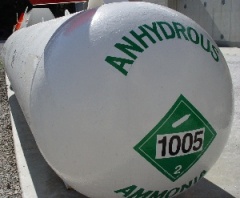Ammonia (anhydrous)
| Infobox on Ammonia (anhydrous) | |
|---|---|
| Example of Ammonia (anhydrous) |  |
| Facts | |
| Origin | - |
| Stowage factor (in m3/t) |
|
| Humidity / moisture | - |
| Ventilation | - |
| Risk factors | See text |
Ammonia (anhydrous)
Description
Anhydrous ammonia is a colorless gas (or liquid); sharp, intensely irritating odour; lighter than air; easily liquefied by pressure.
Ammonia is a compound of nitrogen and hydrogen with the formula NH3. It is a colourless gas with a characteristic pungent odour. Ammonia contributes significantly to the nutritional needs of terrestrial organisms by serving as a precursor to food and fertilizers. Ammonia, either directly or indirectly, is also a building block for the synthesis of many pharmaceuticals. Although in wide use, ammonia is both caustic and hazardous. In 2006, worldwide production was estimated at 146.5 million tonnes. It is used in commercial cleaning products.
Ammonia, as used commercially, is often called anhydrous ammonia. This term emphasizes the absence of water in the material. Because NH3 boils at -33.34°C at a pressure of 1 atmosphere, the liquid must be stored under high pressure or at low temperature. Its heat of vapourization is, however, sufficiently high so that NH3 can be readily handled in ordinary beakers, in a fume hood (i.e., if it is already a liquid it will not boil readily). "Household ammonia" or "ammonium hydroxide" is a solution of NH3 in water. The strength of such solutions is measured in units of baume (density), with 26 degrees baume (about 30% w/w ammonia at 15.5°C) being the typical high concentration commercial product. Household ammonia ranges in concentration from 5 to 10 weight percent ammonia.
Derivation: From synthesis gas, a mixture of carbon monoxide, hydrogen, carbon dioxide, and nitrogen (from air) obtained by steam reforming or by partial combustion of natural gas or from the action of steam on hot coke.
Application
Fertilizers, either as such or in form of compounds, e.g., Ammonium Nitrate, manufacture of nitric acid, hydrazine hydrate, hydrogen cyanide, urethane, acrylonitrite, and sodium carbonate; refrigerant, nitriding of steel, condensation catalyst, synthetic fibres, dyeing, neutralizing agent in petroleum industry, latex preservative, explosives, nitrocellulose, urea-formaldehyde, nitroparaffins, melamine, ethyl-enediamine, sulfite cooking liquors, fuel cells, rocket fuel, yeast nutrient, developing diazo films.
Shipment/storage/risk factors
Hazard Inhalation of concentrated fumes may be fatal. TLV: 25 ppm in air. Moderate fire risk, explosive limits in air 16% to 25%. Forms explosive compounds in contact with silver or mercury.
Anhydrous ammonia is classified as toxic (T) and dangerous for the environment (N). The gas is flammable (autoignition temperature: 651°C) and can form explosive mixtures with air (16–25%). The permissible exposure limit (PEL) in the United States is 50 ppm (35 mg/m3), while the IDLH concentration is estimated at 300 ppm. Repeated exposure to ammonia lowers the sensitivity to the smell of the gas: normally the odour is detectable at concentrations of less than 50 ppm, but desensitised individuals may not detect it even at concentrations of 100 ppm. Anhydrous ammonia corrodes copper- and zinc-containing alloys, and so brass fittings should not be used for handling the gas. Liquid ammonia can also attack rubber and certain plastics.
Ammonia reacts violently with the halogens. Nitrogen triiodide, a primary high explosive, is formed when ammonia comes in contact with iodine. Ammonia causes the explosive polymerisation of ethylene oxide. It also forms explosive fulminating compounds with compounds of gold, silver, mercury, germanium or tellurium, and with stibine. Violent reactions have also been reported with acetaldehyde, hypochlorite solutions, potassium ferricyanide and peroxides.











